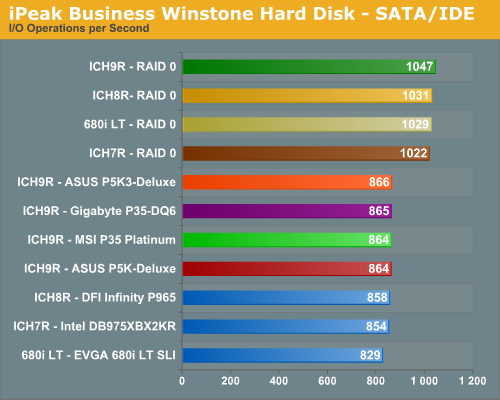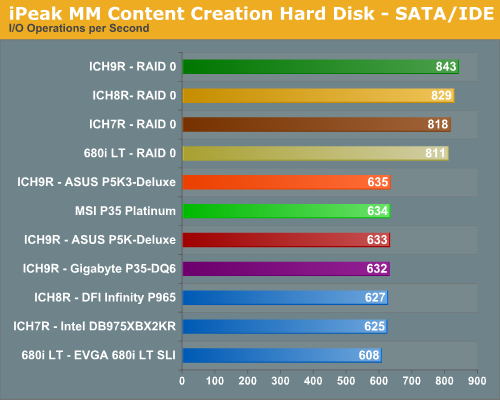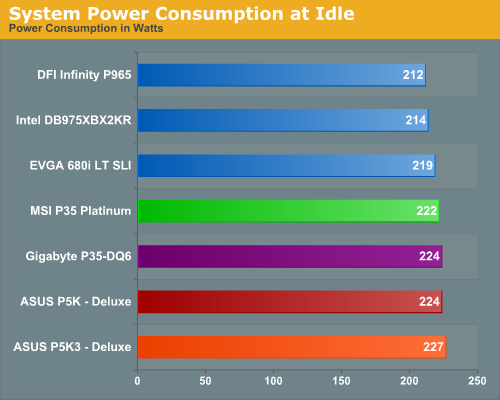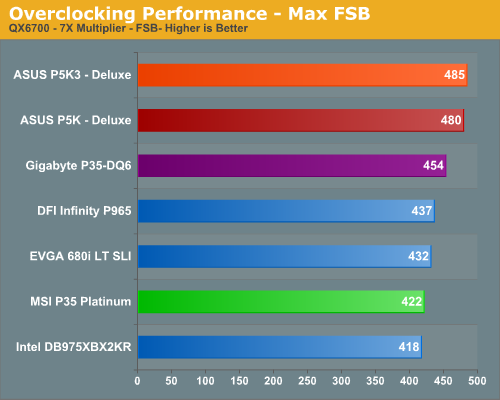Intel P35: Intel's Mainstream Chipset Grows Up
by Gary Key & Wesley Fink on May 21, 2007 3:45 PM EST- Posted in
- CPUs
Disk Controller Performance
The AnandTech iPeak test is designed to measure "pure" hard disk controller performance, and in this case we keep the hard drive as consistent as possible while varying the hard drive controller. The idea is to measure the performance of each hard drive controller with the same hard drive. We report the scores as an average number of I/O operations per second so that higher scores translate into better performance. This number is somewhat meaningless as far as hard disk performance is concerned; however, the scores are useful for comparing "pure" performance of the storage controllers in this case. Results are taken from trace files of Winstones 2004. Due to compatibility issues with Vista, our IPEAK tests are run on Windows XP SP2.

The performance patterns hold steady across both Multimedia Content I/O and Business I/O with the ICH9R outperforming the Intel ICH7R, Intel ICH8R, and NVIDIA 680i chipsets in our tests. Intel told us we should see up to a 4% difference between the ICH9 and ICH8; while our tests do not reveal that, we have noticed a difference in actual usage within Vista, especially when transferring large files. We will have Vista specific tests in the near future. Although our NVIDIA boards generally score lower in these "pure" throughput tests, we find their actual performance in disk intensive applications are generally equal to other solutions during actual usage. We did not experience any RAID 0 issues with the NV controller or drivers under Vista during normal usage but users have reported their RAID arrays degrading over time. We are still investigating these issues.
Power Consumption
As always, we measured power consumption at two states: at idle sitting at the Vista desktop and under load while running our 3DMark06 and Company of Heroes benchmarks. At both settings, EIST/C1E were disabled to show power usage with the system in a normal desktop state.


The surprise is that despite a 16W TDP, the P35 boards actually consume more power than the other chipsets at both idle and load. Even though the DDR3 board has a lower power rating for the memory, it consumes more power than the DDR2 board due to additional circuitry . We can no longer say that NVIDIA is the only high performance chipset approved by OPEC.
FSB Overclocking

Our FSB overclocking results are limited to the quad core QX6700 for this article. We will greatly expand our overclocking results for the roundup that will include five different CPUs. Our ASUS boards overclock the quad core the best at this time thanks to a fairly mature BIOS and great board design. Our Gigabyte and MSI boards have improved greatly over the last week with new BIOS designs and we expect overclocking to improve before the official launch date. In limited testing with the E6600, we were able to hit a 576 FSB on the ASUS boards, 514 on the Gigabyte board, and 508 on the MSI board with the latest BIOS releases.










58 Comments
View All Comments
yacoub - Monday, May 21, 2007 - link
I think HardOCP's conclusion is pretty honest. These boards are a first gen DDR3 setup that has to transition well from DDR2. Performance will be similar, they will offer a few new decent hardware features, but beyond that for most folks they should stick with their P965 or 650i/680i boards and their speedy DDR2 and wait until around a year from now when DDR3 will start to appear that legitimately outperforms DDR2 in a noticeable way and hopefully by then is cost competitive with DDR2.Right now we can get 2x1GB matched pairs of decent PC6400 DDR2 for around (and under) $100. When DDR3 reaches prices like that they'll see more converts from the enthusiast crowd. Or when they start showing performance gains on the order of 15-25% over DDR2.
tomoyo - Tuesday, May 22, 2007 - link
I don't think anyone should be thinking about an upgrade from a p965 in the first place, you've already gotten a core 2 duo and are waiting for the next gen of penryn! Obviously the point of this motherboard chipset is for new buyers, especially people who do not have a core 2 duo in the first place. That is exactly what my situation is, I'm sitting on an amd platform still and looking into when a good chipset/cpu combo is out. The P35 is it for myself, I like the higher fsb overclock and full set of features, hopefully the price will come down quickly as well. Also it's finally gotten to a point where we can get a full set of sata devices with no ide involved...which eliminates the jmicron issue.Wesley Fink - Monday, May 21, 2007 - link
If we were buying a new board today it would be P35 - based on our test results and not our untested opinions. Gaming is faster, memory performance is faster (even with DDR2), and the 1333 processor bus gives current C2D owners a "free" 25% overclcok in most cases.We would likely buy a P35 that supports DDR2 memory, because there is a large price difference in DDR2 and DDR3 right now, and DDR2 is just as fast as DDR3 on the P35 at the same speed and timings - and DDR2 is faster on P35 than P965.
However, we already have our first samples of low-latency DDR3 in for testing. Recommending DDR3 will be about how fast we see price parity with DDR2 as it is definitely the memory of the future.
suryad - Tuesday, May 22, 2007 - link
Any ideas on when an SLI based P35 setup would be released? That is about the only thing that is holding me back from purhcasing a P35 mobo. I want SLI.yacoub - Monday, May 21, 2007 - link
"If we were buying a new board today "Right. And the HardOCP editorial was writing more for those of us who already own a fairly recent board and are wondering if the performance is significant enough to warrant another upgrade. Conclusion: it isn't.
You're both right, in other words. If you're buying a new board today, no major reasons NOT to buy a P35 unless it's a DDR3 one in which case DDR3 is cost prohibitive and offers little to no real performance benefit. If you already have a P965, 650i, 680i, etc, no reason to upgrade.
tomoyo - Tuesday, May 22, 2007 - link
Actually that's not true, according to Kyle, he's endorsing the P965 for all users, new or old. I think he's gotten far too distrustful for new products, especially when this one looks pretty promising. Since the P35 is more of an evolution than anything else, it's a good possibility that we'll get some pretty stable products right off the bat. And I'm of the opinion that a cheap 5% performance upgrade and mobo with full penryn voltage support is worthwhile at the right price for any new user. I do think it'll be a good idea to wait about a month and see if there is any fallout before diving in.Wesley Fink - Monday, May 21, 2007 - link
That was an editorial, not a review. There was not a single test result in that article.On the other hand, we are late to NDA because we got 3 new P35 boards on Friday, and we wanted to bring you real test results based on four motherboards. Our comments and conclusions are based on testing a large number of P35 motherboards, and both DDR2 and DDR3 memory on these boards.
michal1980 - Monday, May 21, 2007 - link
I know, but his conculsion was to get a mature p965, yours a p35. uggh.JarredWalton - Monday, May 21, 2007 - link
With the testing results provided here (and in our previous articles), we're comfortable in saying that P35 is already quite mature, particularly the ASUS boards. If you already have a P965 board there's not much reason to upgrade, but if you're buying a new board we would take a serious look at P35 offerings.TA152H - Monday, May 21, 2007 - link
I was seriously considering getting one of these boards, but I wouldn't even think about it after your review. What the heck is going on with the power use???? The improvement in performance, to me, is a lot less noticeable than the damn noise you'll have trying to evacuate the heat from the motherboard. What a disappointment. The interesting thing is, another site that ran the power use came in lower than the P965, so I'm really confused which is right. My gut instinct is, they are, because this is a 90nm chip with lower specified power use, but I'm sure you guys knew that and were just as confused and made sure your results were correct. I don't get it at all. It's really disappointing, but maybe with future revisions Intel will get the power down to normal levels.I now think supporting DDR2 was a mistake, sure it's good today, but prices for DDR3 will come down, and they would come down fast if Intel made it only DDR3 since memory makers would be very motivated to get their act together. Plus, you'd pay LESS for the chipset, and you'd pay less in electricity for it, and you'd pay less for the motherboards since they wouldn't need as extravagant a cooling solution on it (although, I may buy a MSI just to have that roller coaster. I'm not sure why they felt that design was necessary, but I feel like I need it now. ). So, sure, the cost right now of DDR3 would offset it, but that point will be crossed, and for the rest of the life of the chipset, people will be paying for something that is completely unnecessary and useless, which DDR2 support will be. The P965 would have been fine for legacy support, you don't NEED a P35, and for those folks that wanted it, DDR3 would be fine. Maybe the X38 will drop the dreaded DDR2 support since it's a high-end solution and doesn't need to be shackled with DDR2 support. I hope so.